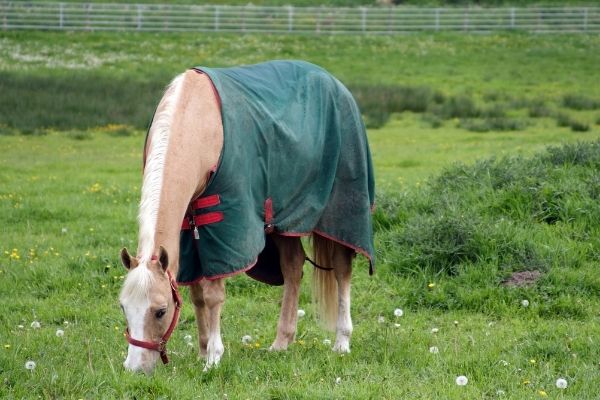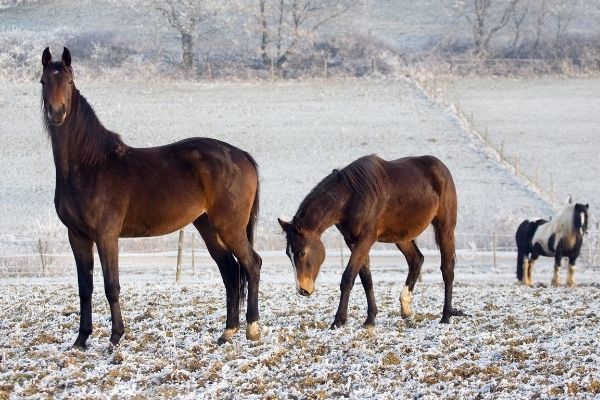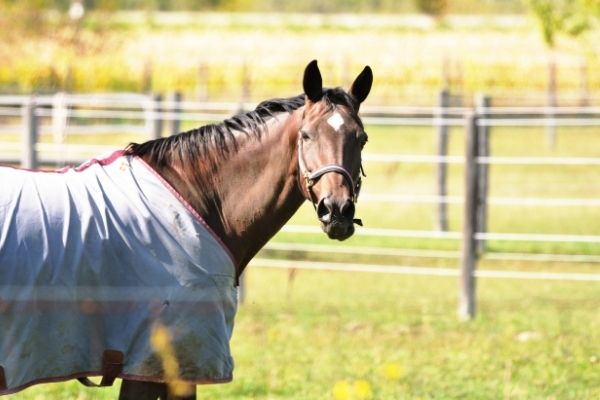The subject of “rugging horses” is a hotly debated topic every year. Horse owners ask themselves when they should put a rug on their horse, what type of rug they should put on or whether to rug at all. There are various reasons why you should put a blanket on but there are also reasons when and why to not use a rug. In this article you will find out when and why it makes sense to put a rug on and which horse rugs can be used when.
Contents
When should you rugging horses?
By autumn at the latest, many horse owners start asking themselves whether they should start rugging their horse. As temperatures drop horses begin to develop a winter coat. But at what point is it worth rugging a horse and for which horses would it make sense?
Especially horses with a rather fine coat should be blanketed from a certain point on. More robust breeds such as Haflingers, various ponies or even Fjord horses and Icelandic horses often do not need a winter rug. They are perfectly able to protect themselves from wind and weather without an extra cover. However, especially sport horses with finer coats should be rugged. It varies how and when exactly a rug should be used. The table at the bottom of the article will provide some help. Especially horses that regularly work and sweat take longer to dry which may result in a cold. Clipping these horses is therefore recommendable.
Disadvantaged horses
Clipped horses are missing the protective undercoat and should definitely be rugged. They no longer have long hairs that can stand up and form an insulating layer and are dependent on the extra protection of a rug. Older horses usually also need a rug, as the immune system no longer functions as well as it does in younger horses. With less training or exercise, an old horse’s muscles, which it needs to keep warm, diminish. Similarly, older horses often struggle with metabolic disorders or dental problems, which means they absorb less food. As a result, they have less energy to keep warm.
When schould you rug a horse?
If a horse is clipped, old or sick, it should be covered with a light blanket at temperatures below 10 degrees. The same applies to horses that live in open stables and are not robust breeds, which have a correspondingly thick undercoat that protects them from environmental influences..
What is thermoregulation in horses?
The comfort temperature of horses is between 5°C and 15°C outside temperature. Their core body temperature is 38°C. Horses are able to keep this temperature constant even in the case of external temperature deviations. Thermoregulation means that a body can keep its core temperature constant regardless of the outside temperature. Horses can cool their bodies through the skin by sweating. Cooling also happens through dilatation of the blood vessels.
Thermoregulation also means that horses change their coat when the seasons change. When the horse needs to warm up its body, the hair follicle muscles erect the hairs and an insulating cushion is formed that protects from the cold. In addition, hypodermic fatty tissue can insulate well from the cold. Horses with a good insulating ability can be recognised in winter by the fact that snow remains on the coat without melting.

Thermoregulation means that a body can keep its core temperature constant regardless of the outside temperature.
Do horses get cold in winter?
A horse’s thermoregulation works even in the case of large external temperature changes. However, horses generally tolerate cold and wet weather better than hot or even muggy weather. The moisture that would normally evaporate in hot weather cannot escape properly when humidity tends to be higher in the summer months.
Rain, on the other hand, is less of a problem for horses, as it is diverted through the hair tips of the coat. If it rains for a long time, the coat will eventually soak through. Then the horse begins to shiver which is often misinterpreted: it is not necessarily cold. The shivering can be thought of as a tool to warm up the body. When temperatures are around minus degrees in winter, a horse can keep its body sufficiently at core temperature through its winter coat without a rug. However, this is only possible if various factors are met. If you clip your horse, for example, thermoregulation is only possible to a limited extent. The coat can no longer stand up to form an insulating layer.
Do horses get cold?
Horses can get cold in the winter. By nature, they have good thermoregulation, so they can easily keep their core temperature the same even in sub-zero temperatures. They often start to freeze when they are clipped and exposed to cold weather without a blanket, are old or sick, or have problems with their metabolism.
Different types of rugs
Cooler rugs
A cooler rug is especially important in winter when horses sweat during training. When the sweat evaporates, the cold outside temperature can cause the horse’s body to cool down too quickly. A cooler rugs helps to absorb the sweat and prevents the horse from getting a chill. After the horse has stopped sweating, the cooler rug should be taken off. If it is left on for too long the horse may often start sweating again.
Under rugs
Under rugs can be used for additional padding and warmth under a turnout or rain rug. They have hardly any dirt or water repellent function and only serve to keep the horse warm. They are practical for upgrading turnout rugs with any additional “fillings”.
Stable rugs
Stable rugs are particularly suitable for horses that are clipped and need additional warmth from a blanket. Although they are somewhat dirt and water repellent, they are not made for daily use in the paddock. Stable rugs are also available with different fillings so that a suitable option can be found for every temperature range in winter.
Rain rugs
Rain rugs are dirt and water repellent and protect the horse from wind and rain over a longer period of time. To remain waterproof for a long time, they should have a high denier count and be well impregnated.
Turnout rugs (with or without filling)
Turnout rugs protect against dirt, wind and water. They are sufficiently waterproof and protect the horse in different weather conditions. The horse stays dry under a turnout rug even in rain and snow. There are rugs with normal or long neck parts, with gussets on the front legs, cross surcingles or other practical details. Turnout rugs are particularly hard-wearing, yet breathable and are available without any filling or with different fillings.
Which horses need a rug?
Especially old or sick horses as well as horses that are clipped often need a blanket during the cold months. Whether the horse should be blanketed should be weighed from horse to horse based on several important factors. Covering a horse too early or too thickly can be harmful and anything but comfortable for the horse.
Rugging horses: Why it is so important
It is especially important rugging horses when they are clipped. This is often done if the horse’s coat is too long or if the horse is exercised regularly and sweats.
Likewise, rugging is important for horses that are older or have health problems. Often horses with metabolic diseases have difficulties in the coat change. They produce an excessive amount of coat and then need a lot of time to cool down and dry after exercise. If such horses are not clipped, you should use a cooler rug so that the horse can return to the stable or paddock dry. If they are clipped, they should also be rugged to prevent colds. In old or sick horses, the natural thermoregulation often does not function properly and you should consider rugging. It can also prove useful if horses are exposed to different weather conditions.

Rugging Horses: Which horse needs which blanket?
Horses kept outside or in open stables
Horses kept outside are permanently exposed to different weather conditions and may need warm rugs in the cold season. During long periods of rain or snow and low temperatures horses have little opportunity to recover well with permanent thermoregulation. Robust horse breeds have it easier in such cases. They can manage without a rug even when kept outside.
Horses that spend a lot of time in the stable
For horses that spend a lot of time boxed and occasionally go out to the paddock or the walker, the rugging process is a little more complex. As the inside stable temperature is considerably higher than outside they can quickly start sweating in the box with the rug on. When they try to cool down again muscle tension or coughing can occur.
In addition, perspiration cannot escape under the blanket, which is often very uncomfortable for the horse. If, on the other hand, a stabled horse has a lot of winter coat, it is usually not necessary to rug at all or enough to use a thin stable rug on much colder days. However, it should not be left out in the rain or snow. Rugging stabled horses is therefore more time-consuming, as you have to change rugs frequently and worry about the correct type of protection.
Old and thin horses
Old and thin horses usually have a slower metabolism and use too much energy to keep warm, which can be very exhausting, So they are often grateful to be tucked in. However, care should also be taken that they do not stand there with a blanket at a few plus degrees. At plus 10 degrees, for example, a rug only makes sense if they are also exposed to rain and wind.
Clipped horses
Clipped horses should be rugged when the temperature drops below 10 degrees and especially when it is windy or rainy, as they are no longer able to keep warm on their own. The hair can no longer stand up when the coat is clipped and unable to create that insulating layer. The independent thermoregulation only functions to a limited extent.
Should I rug my horse when it is raining?
If a horse is going to be exposed to rain for an extended period of time, it should be blanketed when cool temperatures below 10 degrees are consistent. Covering horses in the rain in spring, summer or fall can backfire. The four-legged friends then quickly begin to sweat under the blankets. This can be very uncomfortable and cause muscle tension.
Rugging your horse — The ideal rug for your horse
To select the ideal horse rug, consider the following factors: Is the horse old or sick? How cold or warm are the outside temperatures? Is rain, wind or snow forecast? What physical condition is your horse in? Is it exercised a lot and does it sweat much? Does it never sweat and has a good thick coat? What size is the horse? Does it stand in a box or does it go to the paddock? Does it have to withstand different weather conditions? Then you can decide on the
- filling
- number of grams and
- fit
You can find a rough guideline in the table below.

Finding the right rug and when to rug is not an easy decision. Our rough guideline should help.
At what temperatures should a horse be covered?
For horses that are stabled and come out during the day or for clipped horses, you can follow the guidelines in the table. However, this information only serves as a rough guide: Consider the factors described above in order to decide whether the horse should be blanketed or not.
Temperature | Non-clipped horse | Clipped horse |
Below +10°C | No rug / rain sheet with no fill | Cooler rug or thin cotton rug |
Below +5°C | Cooler rug, thin cotton rug or rain sheet with thin fleece lining | Light rain sheet with up to 150g fill |
Below 0°C | Rug with up to 150g fill | Heavier rug with 300g fill or more |
Below -7°C | Rug with up to 150g fill | Heavier rug with 300g fill or more |
Below -15°C | Rug with 220g fill or more | Heavier rug with 300g fill or more |
At what temperatures does my horse necessarily need a blanket?
Horses can handle sub-zero temperatures without a blanket due to their natural thermoregulation. The winter coat protects them from winter temperatures. Whether to blanket depends on the age, health condition but also the type and breed of the horse. From temperatures below -5 degrees most horses should be covered.
Finding the right rug size
The following rug sizes can be used for different types of horses:
- 155 cm: Suitable for large warmbloods from 170 cm and smaller horses with long backs.
- 145 cm: Suitable for warmbloods between 160 cm and 170 cm, large horses with short backs or smaller horses with long backs.
- 135 cm: Suitable for narrow thoroughbreds, small warmbloods with short backs or full-sized ponies.
- 125 cm: Suitable for small thoroughbreds, small horses or ponies between 130 cm and 145 cm in height.
- 115 cm: Suitable for medium sized ponies
- 105 cm: Suitable for small ponies
Cleaning horse rugs properly
Some stables offer a professional rug wash service. They clean the blankets gently and can also re-impregnate them. However, if you want to clean your rugs yourself, you should pay attention to a few things:
- Brush thoroughly before washing
- Remove hair as much as possible
- Soak the blanket before washing if necessary
- Use a detergent that is gentle on the skin
- Do not wash the blanket hot
- Allow the blanket to air dry

1 comment
It’s an remarkable article in support of all the internet people; they
will take advantage from it I am sure.